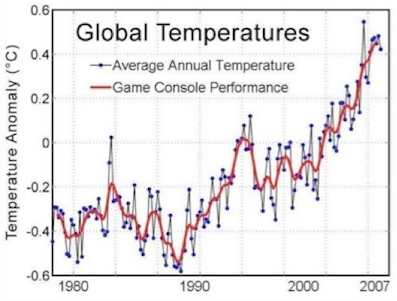History of game consoles

It is now more than 30 years since the first real game console (the Atari 2600) was released in Canada. Below is a timeline of each major console, the CPU/GPU they used and any other neat stuff. Basically, you will notice two important trends:
-
The console manufacturers love to copy each other - up to the mid-1980s, they mostly had MOS 6502-based CPUs - in the late 1980s and early 1990s, they had Motorola 68000-based CPUs - in the mid-1990s to early 2000s they mostly had MIPS-based RISC CPUs - and today they all have PowerPC-based RISC CPUs and complex GPUs.
-
The processing power of game consoles has increased steadily since the early 1980s in response to consumer demand. Today, you can cook a five course meal on a Playstation 3 or Xbox 360. The graph here compares the average compute power since 1977 to the average global temperature rise. I can definitely see a correlation here. The true cause of global warming - I can’t believe I didn’t see it before.
Atari 2600 (1977)
- MOS 6507 CPU (based on the MOS 6502 CPU from the Commodore 64)
Atari 5200 (1982) and Atari 7800 (1986)
- MOS 6502C CPU (not much better than the CPU from the Atari 2600)
Nintendo NES (1985)
- MOS 6502-based CPU
Sega Master System (1986)
- Zilog Z80 CPU (same CPU used in the ZX81)
Sega Genesis (1989)
- Motorola 68000 CPU (same CPU used by early Macintoshes)
- Zilog Z80 for sound
Nintendo SuperNES (1991)
- 16-bit MOS 6502-based CPU (much faster than in NES)
Atari Jaguar (1993)
- Motorola 68000 CPU from the early Macintosh, plus a 32-bit RISC GPU
Atari Jaguar II (1995)
- 32-bit RISC CPU and GPU (Atari was pretty much dead by this time though)
Sega Saturn (1995)
- Two 32-bit RISC CPUs and two RISC GPUs (hard to make games for at the time)
Sony Playstation (1995)
- 32-bit MIPS R3000-based RISC CPU (same CPU found in early Silicon Graphics computers)
Nintendo 64 (1996)
- 64-bit MIPS R4300-based RISC CPU (same CPU found in Silicon Graphics computers used to render the graphics in movies - extremely powerful even today)
- SGI GPU
Sega Dreamcast (1999)
- 32-bit RISC CPU, GPU and Sound CPU (very fast and powerful)
- Did well in the market, but not well enough to survive the Playstation and Xbox (it was Sega’s last game console)
Sony Playstation 2 (2000)
- 64/128-bit MIPS 5900-based RISC CPU (same CPU found in many Silicon Graphics computers in the late 1990s)
- MIPS-based RISC GPU
- MIPS R3000-based RISC CPU for I/O
Xbox (2001)
- 32-bit Intel Pentium III CPU (most common CPU in PCs at the time)
- NVIDIA graphics GPU (very nice)
Nintendo Game Cube (2001)
- 32-bit PowerPC G3 RISC CPU (same CPU in Apple iMac G3s)
- ATI graphics GPU
Xbox 360 (2005)
- 64-bit PowerPC G5 CPU with 3 cores (running extremely fast - the G5 was used in high-end Macintoshes and IBM Servers at the time)
- ATI graphics GPU (faster than in original Xbox)
Nintendo Wii (2006)
- 32-bit PowerPC G3 RISC CPU (much faster than in the Nintendo Game Cube)
- ATI graphics GPU (much faster than in the Nintendo Game Cube)
- Wireless controllers that respond to 3D movement (for exercise)
Sony Playstation 3 (2006)
- 64-bit PowerPC Cell RISC CPU with 7 cores (OMFG powerful - runs Linux fast)
- NVIDIA GPU (very nice)
- Some early models also had the MIPS 5900-based CPU from the Playstation 2 for backwards compatibility for those games (it is now done with just software emulation)